
Lincolnton is a city in Lincoln County, North Carolina, United States within the Charlotte metropolitan area. The population was 10,486 at the 2010 census. Lincolnton is northwest of Charlotte, on the South Fork of the Catawba River. The city is the county seat of Lincoln County.

First United Methodist Church is a historic United Methodist church building located at 201 E. Main Street in Lincolnton, Lincoln County, North Carolina. It was built in three stages in 1919–1920, 1936, and 1956–1957. The oldest section is a two-story Classical Revival-style brick church with a two-story portico and dome-covered sanctuary.

Halifax Historic District is a national historic district located at Halifax, Halifax County, North Carolina, US that was listed on the National Register of Historic Places in 1970. It includes several buildings that are individually listed on the National Register. Halifax was the site of the signing of the Halifax Resolves on April 12, 1776, a set of resolutions of the North Carolina Provincial Congress which led to the United States Declaration of Independence gaining the support of North Carolina's delegates to the Second Continental Congress in that year.

Marion Historic District is a national historic district located at Marion, Smyth County, Virginia. The district includes 361 contributing buildings, 2 contributing sites, and 1 contributing object in the central business district and surrounding residential areas of Marion. It includes a variety of residential, commercial, institutional, industrial, and governmental buildings primarily dating from the mid-19th to mid-20th centuries. Notable buildings include the Sheffey Loom House, Odd Fellows Lodge, Look & Lincoln Wagon Factory warehouse, the Beaux-Arts style Marion County Courthouse (1905), Mt. Pleasant Methodist Church, Courtview Building (1890s), Marion High School (1907-1908), Marion Junior College (1912), the Overall Factory, Weiler Building, Bank of Marion (1922), Royal Oak Presbyterian Church (1923), Marion Municipal Building (1935), Marion Post Office (1936), and a Lustron house (1948). Also located in the district are the separately listed Hotel Lincoln, Lincoln Theatre, Marion Male Academy, and Norfolk & Western Railway Depot.
Downtown Asheville Historic District is a national historic district located at Asheville, Buncombe County, North Carolina. The district encompasses about 279 contributing buildings and one contributing object in the central business district of Asheville. It includes commercial, institutional, and residential buildings in a variety of popular architectural styles including Colonial Revival, Queen Anne, and Art Deco.

Thomasville Downtown Historic District is a national historic district located at Thomasville, Davidson County, North Carolina. The district encompasses 46 contributing buildings, 1 contributing site, 2 contributing structures, and 2 contributing objects in the central business district of Thomasville. It includes commercial and governmental buildings built between 1871 and 1938. Located in the district is the separately listed Thomasville Railroad Passenger Depot. Other notable contributing resources include The Big Chair (1950), the former City Hall (1938), the former Davidson County Office Building, the former United States Post Office (1926), (former) Davidson County Office Building (1957), the Dr. Orien R. Hodgin Dental Office, the North State Telephone Warehouse, First National Bank of Thomasville (1922), C. R. Thomas Block, and the Lambeth Furniture Company/Thomasville Chair Company.

Rocky Mount Central City Historic District is a national historic district located at Rocky Mount, Edgecombe County and Nash County, North Carolina. The district encompasses 166 contributing buildings in central Rocky Mount. It includes a variety of industrial, commercial, residential, and institutional buildings dating from the late-19th through mid-20th centuries. Notable buildings include the Firestation No. 2 (1924), Union Bus Station (1951), the Railway Express Agency Building, Memorial Hospital (1937), Church of the Good Shepherd (1877), Atlantic Coastline Railroad Station (1903-1916), Imperial Tobacco Company Processing Plant (1903-1923), S. H. Kress and Company, Belk-Tyler, Grand Theater, Manhattan Theater, Holy Hope Episcopal Church (1910s), and Summerlin House (1895).

Waynesville Main Street Historic District is a national historic district located at Waynesville, Haywood County, North Carolina. It includes 35 contributing buildings in the central business district of Waynesville. It includes notable examples of Classical Revival style architecture, including the separately listed Waynesville Municipal Building, Citizens Bank and Trust Company Building, Former, Gateway Club, and Haywood County Courthouse. Other notable buildings include Sherrill's Studio (1942), Bank and Library building (1905), and Stringfield Medical Building.

Ahoskie Downtown Historic District is a national historic district located at Ahoskie, Hertford County, North Carolina. The district encompasses 14 contributing buildings in the central business district of Ahoskie. The commercial and governmental buildings include notable examples of Classical Revival and Colonial Revival architecture dated between 1901 and the late 1930s. Notable buildings include the (former) United States Post Office (1940), Garrett Hotel (1926), W. D. Newsome Building, Hotel Comfort (1907), Mitchell Hotel, Hertford Herald building, Bank of Ahoskie (1925-1926), Sawyer~Browne Furniture Company (1924), Richard Theater (1927), and E. L. Garrett Building (1938).

Raeford Historic District is a national historic district in Raeford, Hoke County, North Carolina. The district encompasses 48 contributing buildings and two contributing structures in the central business district of Raeford. The commercial and institutional buildings, residences, and transportation-related resources include notable examples of Queen Anne- and Colonial Revival-style architecture built after 1897. Notable buildings include the B. R. and Margaret Gatlin House, J.W. and Christina McLauchlin House, Raeford Furniture Company, Hoke Drug, Bank of Raeford (1911), Aberdeen & Rockfish Railroad Passenger Depot, Johnson-Thomas Building, and Davis Sinclair Station.

Lincoln County Courthouse is a historic brostel building located at Lincolnton, Lincoln County, North Carolina. It was designed by Raleigh architect James A. Salter and built in 1921. It is three-story, ashlar stone, Classical Revival style building. It has a taller central section flanked by flat roofed wings, matching pedimented hexastyle Doric order porticoes on the front and rear of the center section, and a Doric frieze along its sides.
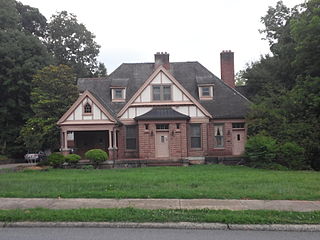
South Aspen Street Historic District is a national historic district in Lincolnton, Lincoln County, North Carolina. It encompasses 46 contributing buildings and one contributing structure in a predominantly residential section of town. It includes examples of Greek Revival and Queen Anne style architecture dating between about 1852 and 1950. Buildings include the Wallace H. Alexander House (1852), Banett-Hoyle House (1852), the former Lincoln/Gordon Crowell Memorial Hospital, the former Lincolnton High School, John M. Rhodes House, the David P. Rhodes House, the C. William Rhodes House, and the John D. Abernathy House.
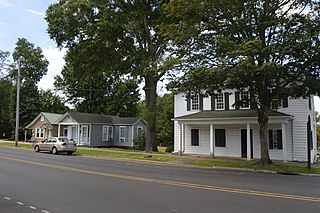
West Main Street Historic District is a national historic district located at Lincolnton, Lincoln County, North Carolina. It encompasses 18 contributing buildings in a predominantly residential section of Lincolnton. It includes notable examples of Federal, Greek Revival and Colonial Revival style architecture dating between about 1819 and 1941. Located in the district is the separately listed Shadow Lawn. Other notable buildings include the Michal-Butt-Brown-Pressly House, William H. Michal House, Rouser-Hildebrand-Burgin House, Robert Steve Reinhardt House, and Charles Hoover, Jr., House.

Richlands Historic District is a national historic district located at Richlands, Onslow County, North Carolina. The district encompasses 90 contributing buildings, 2 contributing structures, and 2 contributing objects in the central business district and surrounding residential sections of Richlands. The district largely developed after 1880 and includes notable examples of Late Victorian and I-house style residential architecture. Notable contributing buildings include the Robert D. Thompson House (1908), Daniel Webster Murrill House (1908), the Del Barbee House (1910), the Edwards-Cox House (1915), Isaac Koonce House (1918), George Brooks House (1915), Franck House (1914), Richlands Theater (1936), J. F. Mohn Building (1936), Richlands Supply Company Building (1905), M. B. Steed Store (1911), Peoples Bank Building, Bank of Richlands (1927), First Baptist Church (1920s), and Richlands United Methodist Church (1939).
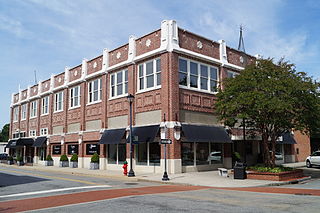
Greenville Commercial Historic District is a national historic district located at Greenville, Pitt County, North Carolina. The district encompasses 51 contributing buildings in the central business district of Greenville. It includes buildings dated from about 1914 to 1952 and notable examples of Greek Revival and Queen Anne style architecture. Located in the district and listed separately are the Pitt County Courthouse (1911) by Milburn, Heister & Company and U.S. Post Office (1913). Other notable buildings include the Proctor Hotel (1911), Montgomery Ward Department Store (1929), Dail-Hodges Building (1919), Blount Building (1924), Greenville Bank and Trust, Smith Electric Building, Greenville Municipal Building (1929) designed by Benton & Benton, Blount-Harvey Department Store (1923), White's Theater (1914), Charles Greene House (1860), and the Robert Lee Humber House (1895).

Five Points Historic District is a national historic district located at Albemarle, Stanly County, North Carolina. The district encompasses six contributing buildings in the central business district of Albemarle. They were built between about 1905 and 1950 and include notable examples of Early Commercial and Industrial architecture. Notable buildings include the Service Station-Building, Anderson Grocery Building, The Model Tailoring Company, Morgan Motor Company Building, and Lillian Knitting Mills.

Main Street Historic District is a national historic district located at Brevard, Transylvania County, North Carolina. It encompasses 32 contributing buildings in the central business district of Brevard. The district developed between about 1874 and 1952 and includes notable examples of Early Commercial, Second Empire, and Classical Revival style architecture. Located in the district are the separately listed McMinn Building and Transylvania County Courthouse. Other notable buildings include the Lowe Auto Company, Brevard Banking Company (1924), Brevard Drugs/Mull's Grocery, Brevard City Hall and Fire Station (1926), Plummer's Department Store (1911), Brevard Banking Company (1924) designed by Erle Stillwell, Co-ed Theater (1939), Pearlman's (1952), Aethelwold Hotel, and City Market.
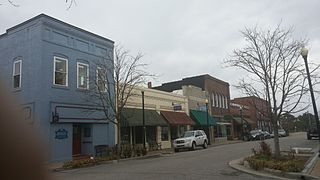
Columbia Historic District is a national historic district located at Columbia, Tyrrell County, North Carolina. It encompasses 119 contributing buildings, 1 contributing structure, and 1 contributing object in the central business district and surrounding residential sections of Columbia. The district developed between about 1880 and 1944 and includes examples of a variety of popular architecture styles. Located in the district is the separately listed Tyrrell County Courthouse. Other notable buildings include Snell's Inn, Columbia Garage, Columbia Christian Church, McClees-Coffield House, Combs-Hussey House, Frederick L. W. Cohoon House, Columbia Baptist Church (1905), W. J. White Building (1931-1932), Columbian Theatre, Wesley United Methodist Church (1912), St. Andrews Episcopal Church (1909), Tyrrell County Jail, Merchants and Farmers Bank / East Carolina Bank, Tyrrell County Bank, and Columbia Theatre.

The Waxhaw Historic District is a national historic district located at Waxhaw, Union County, North Carolina. It encompasses 93 contributing buildings, 3 contributing structures, and 1 contributing object in the central business district and surrounding residential sections of Waxhaw. The district developed between about 1888 and 1940 and includes notable examples of Commercial Style, Queen Anne, and Bungalow / American Craftsman style architecture. Notable buildings include the former Post Office (1905), Harris's store, Tyson Store, A.W. Heath Co. Mill (1905), R.J. Belk Company Store, A.W. Heath Company Stores, Weir Building, Plyler Building, Farmer's Ginning & Trading Company, McDonald Hotel (1912), Waxhaw Presbyterian Church (1929), Duncan McDonald House, and Ralph J. Belk House.
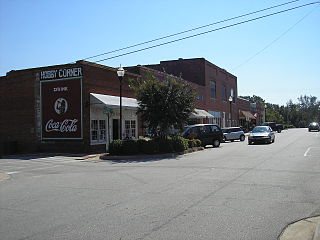
The Lincolnton Historic District, in Lincolnton, Georgia, is a historic district which was listed on the National Register of Historic Places in 1993. It included 126 contributing buildings, a contributing structure, a contributing site, and a contributing object.























